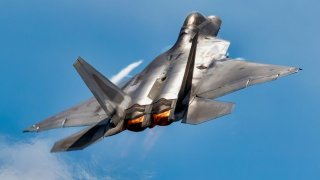The F-22 Raptor Stealth Fighter Has 1 Nearly Fatal Flaw
The F-22 Raptor, the world's first fifth-generation fighter, marked a significant leap in air superiority technology but saw its production halted in 2011 after only 195 units.
Summary: The F-22 Raptor, the world's first fifth-generation fighter, marked a significant leap in air superiority technology but saw its production halted in 2011 after only 195 units. Initiated during the Cold War's peak, the F-22's development benefited from an environment where cost was no object, aiming to outpace Soviet aerospace capabilities. Despite its advanced stealth, speed, and maneuverability, post-Cold War defense spending cuts and a shift in strategic priorities led to the early cessation of its production. With the focus now on the Next Generation Air Dominance program, the still-unmatched F-22 is nearing the end of its operational life, making its appearances at airshows increasingly precious.
The F-22 Raptor's Legacy: Ahead of Its Time, Yet Time Runs Out
The F-22 Raptor was billed as the future of military aviation. The world’s first operational fifth-generation fighter, the F-22, was cutting-edge and may still be the best air superiority fighter in the skies.
But the F-22 is already being phased out; production of the jet halted in 2011 after just 195 F-22s were completed, suggesting that the US Air Force was done with its heralded, and then still relatively new, fighter.
Post-Cold War Sequestration for F-22
The F-22 began as the Advanced Tactical Fighter program (ATF) in the late 1980s, during the climax of the Cold War.
And as the Cold War peaked, America was not shy about investing heavily in defense programs. Aerospace development was particularly concerning to the Americans, as the Soviet Union had proven itself adept at building capable aircraft, with both Sukhoi and Mikoyan producing admirable airframes.
Never content to merely keep pace, the Americans initiated the ATF program to punch out the envelope exponentially, yielding the world’s first fifth-generation fighter.
Of course, punching out the envelope to ambitiously, producing an entirely new generation of aircraft, was not cheap. But in the money-is-no-issue climate of the Cold War, taxpayers were happy to fund an aircraft featuring never-before-seen technology.
The F-22 “was a foray into the future where no one had gone before, wrote pilot and engineer Patrick Bindner. “While it is almost everyday stuff now – it was nothing less than Star-Wars hardware in comparison with existing equipment at both [Lockheed Martin] & the USAF [who] were learning how to do it as they went along that pathway. It was a piece of extreme exotica, using a cost-is-no-object engineering & materials. It looks like an airplane, but it was the very first full-on stealth fighter.”
The result was an aircraft that, nearly three decades later, “is still not only fully relevant to its design goals,” but “is still unmatched in its combat niche.”
So, if the F-22 is so far ahead of its time, still “unmatched in its combat niche,” why was funding pulled and production halted after less than 200 aircraft were built?
The end of the Cold War changed the calculus on defense spending; by the 2010s, with the Soviet threat long gone, the US Air Force entered a sequestration period. The F-22 fell victim to the constrained spending environment. Production was halted. Not a single F-22 has been produced in 13 years – and no more F-22s will be created. The aircraft’s production run is permanently over, and in time, the jet will be phased out of active duty service in favor of the still being developed Next Generation Air Dominance (NGAD) sixth-generation fighter.
Fortunately, the F-22 is still flying, still showing off an impressive array of technological features. Most notable, perhaps, is the F-22’s stealth characteristics. Significant research went into lowering the F-22s radar cross section (RCS) while maintaining the aircraft’s speed and maneuverability.
“To achieve its stealth capabilities, the F-22 Raptor utilizes advanced composite materials, such as carbon fiber composites, which are lightweight yet strong,” wrote Laura Clery. “These materials help reduce the aircraft’s weight, enhance its maneuverability, and improve its overall performance.”
The F-22 won’t be around much longer. Consider finding an airshow in which the F-22 is featured before the jet is mothballed forever.
About the Author: Harrison Kass
Harrison Kass is a defense and national security writer with over 1,000 total pieces on issues involving global affairs. An attorney, pilot, guitarist, and minor pro hockey player, Harrison joined the US Air Force as a Pilot Trainee but was medically discharged. Harrison holds a BA from Lake Forest College, a JD from the University of Oregon, and an MA from New York University. Harrison listens to Dokken.


